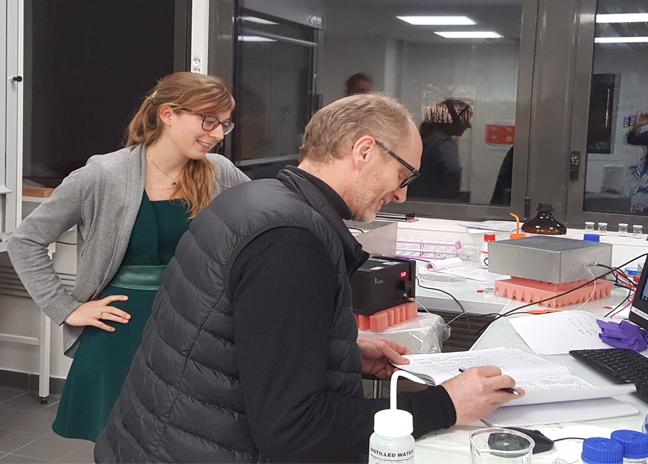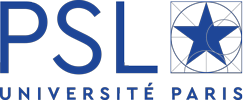From kidneys to water filtration: an example of biomimicry research with significant applications
Exploring new possibilities for water filtration that are inspired in part by the human kidney: that’s the goal of the thesis being conducted by ENS-PSL doctoral student Sophie Marbach under the supervision of Lydéric Bocquet, CNRS Research Director at ENS-PSL and ERC grant recipient.
It’s a unique thesis topic with significant implications for communities, and it’s already won numerous accolades, including a 2017 L’Oréal-UNESCO For Women in Science fellowship awarded to Sophie last fall. We take a closer look at a research collaboration marked by innovation and shared discovery.

A joint interview with ENS-PSL doctoral candidate Sophie Marbach and her thesis director, Lydéric Bocquet.
PSL: Where did you get the idea of looking at kidney function to come up with ways to decontaminate wastewater?
Lydéric Bocquet: As so often happens, the idea came out of a discussion with colleagues. It’s all part of microfluidics – I was interested in the various systems for water flow through the smallest channels possible, including certain pores in the human body, such as the aquaporins found in large numbers in the kidneys. The kidney acts as a natural filtration system, so it made sense to try to imitate how it works so that, for example, we could filter our wastewater more effectively. It’s a topic that had only ever been tackled from a medical standpoint, so Sophie’s first task was to compile the necessary information about the kidney by meeting with physiologists and biologists and exploring the medical literature to see if she could look at kidney function from a different standpoint. She worked very quickly, and while it could have taken her a year or a year and a half, she managed to do it all within a few months.
PSL: As physicists, what did you learn from all of your disciplinary interactions with those biologists and physicians?
Sophie Marbach: It was a very rewarding experience, but also fairly difficult. Our respective disciplines use the same words to describe different phenomena, and different words to refer to the same thing. We had to establish a common language in order to understand each other, but we managed.
Lydéric Bocquet: Yes, it required a shift in our thinking. We tackled one of their subjects to try to bring it closer to physics and find answers for some questions we needed to resolve. Now we have to work in the reverse direction and offer them our observations and results to try to improve their understanding of the kidney. For example, dialysis is a difficult, painful experience for patients. That’s one of our next steps. In addition, thanks to an article we published in Physical Review X, we’ll be meeting in the very near future with a researcher in the Netherlands who specializes in “organs-on-a-chip.”
PSL: Sophie’s presentations of her work and the laboratory’s work more broadly have received a lot of attention (an article in Le Monde, the finale of the Falling walls research competition, a 2017 L’Oréal-UNESCO For Women and Science fellowship). It’s all evidence that scientists and the general public have a shared interest in these topics. What do you see for the future? How much time do you think will be needed to gain some tangible applications for these scientific results?
Our results are encouraging; they prove that we can do much better than the traditional filtration system. But we’re still at the level of basic research.
Sophie Marbach: For the kidney-inspired filtration system we’re still at the testing stage, but we have the theoretical proof that our system could allow for better filtration and use less energy at the same time. We’re currently exploring other avenues, many of which are biomimetic as well, such as the concept of an “active sieve.” What that means is this: currently for water filtration we use the principle of a sieve (or “reverse osmosis”), in which the larger chemicals that represent impurities are blocked by the size of the holes (like spaghetti through a colander), whereas water, as a smaller molecule, can pass through. But that technique doesn’t allow us to separate chemicals that are similar in size. That’s why we created the idea of a sieve with “small doors” that open and close. So imagine that our molecules are like an elderly woman and Usain Bolt, and they’re each waiting to go through the revolving door at a large hotel. If the door moves very quickly, only Usain Bolt will be able to pass through, and the elderly woman will be left outside. On the other hand, if the revolving door moves at an irregular, unpredictable speed, both of them will be prevented from entering. If we can successfully reproduce the vibrations of the membranes found in the human body, we’ll be able to separate calcium from sodium (for example) more easily and at a lower energy cost.
Lydéric Bocquet: Our results are encouraging; they prove that we can do much better than the traditional filtration system. But we’re still at the level of basic research, and we need to complete our panel of testing before we can think about concrete ways to capitalize on the results.
PSL: Sophie, you were one of the 30 winners in France of a 2017 L’Oréal-UNESCO For Woman and Science fellowship. What advice would you give to young women in secondary school who might be hesitating about going into scientific research?
Women in science need to make every effort not to self-censor.
Sophie Marbach: My first and biggest piece of advice would be not to close any doors. You definitely need to work very hard to get to the highest level of science, but science is extraordinary. You should never be afraid of science; on the contrary, it would be a shame to deprive yourself of that knowledge. Even though the number of women who are pursuing scientific study or careers has risen, it’s still sometimes the case that I’m the only woman in lecture halls where I’m teaching a class. Moreover, as in other fields, women in science need to make every effort not to self-censor.
PSL: Sophie, you’re active in a number of PSL organizations. How did Université PSL benefit you as an ENS student?
Sophie Marbach: First and foremost, it gave me a network and an incredible working environment as a researcher. PSL has served as a passport that’s opened doors for me worldwide. Also, as a member of the PSL Symphony Orchestra and Choir, I’ve been able to give concerts in some magical places, and I regularly take part in performances at ENS-PSL as a soprano soloist.
PSL: You obtained the 2017 L’Oréal-UNESCO For Women and Science fellowship, reached the finals of the Falling Walls competition and were awarded CNRS silver medal; both of you had an incredibly successful year in 2017. What are your plans for 2018?
Sophie Marbach: First, I’m going to defend my thesis (before the end of the academic year) and continue my adventure in science. I would like to continue pursuing my physics research, since that’s where I feel most useful. My next step is going to be a long-term research project outside France, so I can develop an international collaboration.
Lydéric Bocquet: To see Martin Fourcade with a medal at the Winter Olympics! I’m working on a research project in partnership with a lab at the Ecole Polytechnique and France’s men’s biathlon team. Our goal is to improve our knowledge of the gliding and waxing mechanisms in skiing. Just recently we’ve found a product that works, but only under certain conditions. It’s being tested by the French Ski Federation. So stay tuned.
